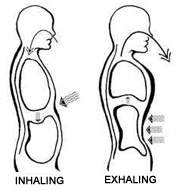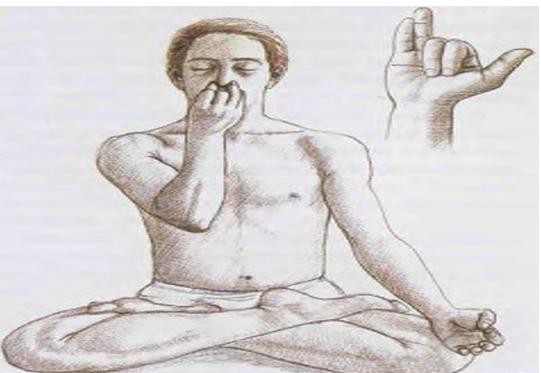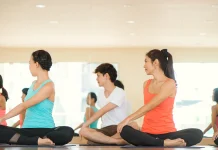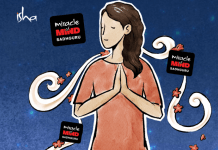Breathing is the gateway to emotions, power and intellect in which our life and soul resides.
Today’s hectic chores and duties leave us literally…breathless! The usage of the phrase “No time to breathe” is used more often than not and day-by-day people are forgetting the core necessity of life… our breath.
The result? Stress, excessive tiredness, poor health, a face with no glow, a mind with deteriorating power and a body that’s lifeless!
So, what must one do in order to actually remember to breathe? Should we all leave our jobs? Or climb up to some mountain for meditation and herbal therapy? NO!
Just learn to breathe with these basic breathing exercises:
DEEP ABDOMINAL BREATHING
-
Lie on your back with your hand on your stomach, between your navel and the bottom of your breastbone.
-
Inhale through your nose and push your stomach out so that you can feel your hand rise. (Do to a count of 4)
-
Exhale through your mouth so you can feel your hand on your stomach drop as your diaphragm displaces the air in your lungs.(Do to a count of 8)
-
Continue at your own rate for 5-10 minutes to begin with. Gradually over time work up to 15-30 minutes per day.
Mastering this basic technique is critical to receiving the maximum benefit of the more complex exercises to come.
Deep abdominal breathing is also called Diaphragmatic breathing. This is differentiated from Thoracic (chest) breathing. Using the diaphragm to breathe uses significantly less energy than using chest and rib muscles and allows more blood to be oxygenated in less time. If you use only the top third of the lungs you are oxygenating only about 1 tablespoon (15 ml) per second, if you use the top two-thirds of the lungs you are oxygenating about a pint (16 oz.) (960 ml.) Per second, if you now include the lower third of the lungs you are oxygenating over a quart at least (32 oz.) (1920ml) per second.
When your breathing becomes short and shallow you are creating an oxygen deficit. You may feel light headed, dizzy, anxious and nervous as experienced earlier. This lack of oxygen affects reflex time, hand and eye coordination, visual acuity, balance, movement and judgment. As stressors build we sometimes slip out of deep abdominal breathing, which only serves to complicate the situation. We seemed to have been trained out of abdominal breathing. How many times have we heard ‘chest out, stomach in’ when we were growing up. This looks nice but what we did not realize of course is that we were also changing the way we breathe.
CURLED TONGUE BREATHING
Here is another breathing exercise:
-
Sit or lie in a comfortable position, close your eyes, relax and place your hands in your lap or at your sides.
-
Extend your tongue out of your mouth and roll it into a “U” shape so as to almost make a tube. (If you cannot roll your tongue into a “U” shape, do the inhale through the nose).
-
Inhale through the rolled tongue in eight separate movements. (At about 2 movements per second) (You will really feel this in your diaphragm)
-
Now exhale through the nose in eight separate movements. (At about 2 movements per second)
-
Repeat the sequence and continue for about 5 minutes. You will notice some very interesting internal changes taking place. (This exercise releases tension, stimulates metabolism and increases energy level and healing)
ALTERNATE NOSTRIL BREATHING
This balances brain hemispheres, produces relaxation and centeredness. Produces clearer prospective and may help with angina pain.
-
Sit or lie in a comfortable position. Keep the spine straight.
-
Close your eyes and focus on the point where your nose and eyebrows intersect.
-
With your left hand in your lap or at your side, place the thumb of your right hand so that it closes your right nostril.
-
Inhale for a count of four through your open left nostril.
-
Remove; your thumb and close your left nostril with middle finger of your right hand. Now exhale through your open right nostril for a count of eight.
-
After the count of eight and continuing to keep the left nostril closed, inhale for a count of four through your open right nostril.
-
Close the right nostril again and exhale through the now open left nostril for a count of eight.
-
Continue this pattern for three to five minutes initially. Gradually work up to ten or twelve minutes. Stop if you begin to feel dizzy.
(Hint – the pattern is: inhale left nostril, exhale right nostril, inhale right nostril, exhale left, inhale left and back to exhale right, etc. The nostril change is always on the exhale.)
BREATHING FOR ENERGY
This exercise increases energy and reduces sluggishness.
-
Stand erect but relaxed, with your hands at your sides.
-
Simultaneously begin a slow steady inhalation through your nose and at the same time raise your arms out to your side, with the palms facing down. Raise your arms until they reach shoulder height.
-
Continuing to inhale, move your arms forward until your thumbs meet out in front of your chest. The arms extended and still at shoulder height.
-
Raise your arms vertically until your fingers are pointing straight up, directly over your head. Hold your breath momentarily.
-
While leaving your hands above your head, exhale through your mouth while dropping your head, neck and shoulders down and slightly forward.
-
Do ten repetitions of this exercise. Coordinate your breathing and arm movements so they are done at a smooth pace.
The more your practice these exercises, the faster you will achieve the desired mental, emotional or physical state you desire. The nervous system, like muscles, becomes more efficient at producing the desired results over time with spaced repetition.









